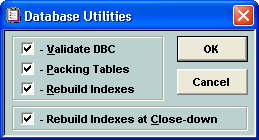| Database Files
|
|
||||||||
| CQLog - 32 bit application and development by Microsoft Visual FoxPro ver.6.0. The author is not the professional programmer (programming mine Hobby).
|
|
|
| CQLog uses CQ.DBC database what is in a Data folder. The database contains tables in which are saved appropriate data (*.dbf files). For some tables there are index files (*.cdx), and memo files (*.fpt) where the large texts are stored (for example notes for QSO). At addition, editing, and deleting of records the tables, the index and the memo files sometimes may be broken. For its correction Database Utilities dialog box is used which appears when you on the File menu, click Rebuild DBC/Reindex (so as this choice became active, it is necessary to close all active windows in the program).
|
|
|

|
|
|
| Dialog Box Options
|
|
|
| Validate DBC
|
| Validates the current database.
|
|
|
| Packing Table
|
| Packs all tables in the current database.
|
|
|
| Rebuild Indexes
|
| Rebuilds indexes for all tables in the current database. Take for a rule after operation with CQLog to make rebuilds indexes.
|
|
|
| Rebuild Indexes at Close-down
|
| Automatic rebuilds indexes at closing the program. Take for a rule after operation with CQLog to make rebuilds indexes. However, it is possible to make this operation automatically, every time at an exit from CQLog if to select it check box.
|
|
|
|
|
| If the index file or the table is broken then at saving data the program under abnormal condition closed. For correction of an index file it is necessary to do the following steps. If it has not given effect please contact to the author.
|
|
|
| In most cases at structure violation of the tables or database as a whole the message Database file are broken will be displayed. If the mentioned above operations on Rebuild Indexes and Packing Table do not give due effect and, besides the message Database file are broken is displayed at attempt Validate DBC, cardinal actions for the tables and database restoring in this case are necessary. In such peak situation close CQLog and make a backup copy of the Data folder firstly (with all files inside). Following step the copying of all files from a Data\Recovery folder into a Data folder thus by replacing in it similar files. Open again CQLog and using the Database Utilities dialog box try again to Validate DBC, Packing Table, and Rebuild Indexes of the tables, i.e. to do the following steps..
|
|
|
| The most unpleasant moment is the damage of the memo file. In a critical case the violation of the memo file does not give at all possibility of opening of the appropriate table and database as a whole. Sometimes in such situation the installation of the program anew and data import from a backup copy helps only. However in this moment the author makes the special Recovery program intended for restoring of the corrupt tables. If you did not correct the corrupt database do not hesitate mailed to the support@cqlog.com. The author has special tools for the data recovery from any corrupt table and even from the formatted or corrupt diskettes is possible free-of-charge.
|
|
|
| At operation with the database it is necessary to know. By clicking Delete button on the toolbar, or by clicking the Delete Record item on the File menu, you delete records by marking them for deletion, but there is no deleting of record from the table and the record is marked, as deleted and is not displayed. Until you remove the records that are flagged for deletion, they are still on disk and can be unmarked and restored. Records you mark for deletion are not physically removed from the table until you issue a Packing Table command. For their physical deleting it is necessary to pack the table having done the following steps. However there is no necessity after each record deleting to make the table packing!
|
|
|
|
|
Do not forget to make backup copies of data!!
|
|
|
|
|
| The CHM file was converted to HTML by chm2web software. |